ASC NANO: High-performance zinc-ion battery based on V2CTX MXene in-situ growth of MnO2 nanosheets
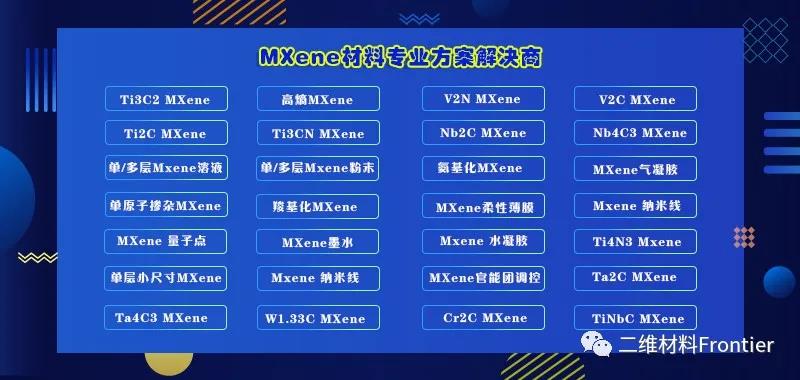
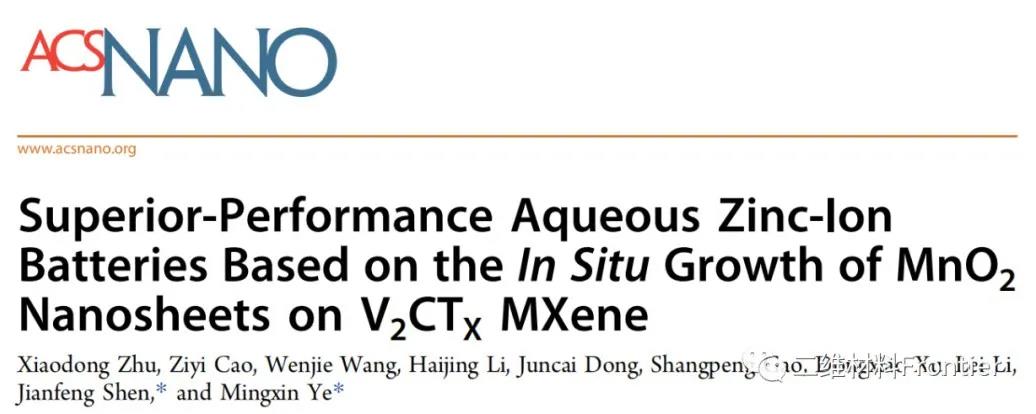
one. Article overview
The manganese-based zinc ion battery has the advantages of simple preparation, low cost and high safety, and is a large-scale rechargeable battery with broad application prospects. However, the low-rate performance and poor cycle performance of manganese-based cathodes hinder the commercial application of manganese-based cathodes. In this paper, metal ion intercalation in-situ growth technology was used to form MnO2 nanosheets uniformly on the surface of V2CTX MXene, and a manganese-vanadium hybrid cathode K -V2C@MnO2 was designed and synthesized. K-V2C@MnO2 has a hybrid structure with high conductivity and abundant active sites, as well as the synergistic Mn2+ electrodeposition reaction and the inhibition of MnO2 structural damage. It shows excellent electrochemical performance for ZIBs in water. Specifically, it exhibits a high specific capacity of 408.1 mAh g-1 at 0.3 A g-1, and maintains 119.2 mAh g-1 at a high current density of 10 A g-1 for 10,000 long-term cycles. The specific capacity. It is superior to almost all ZIBs reported in manganese-based cathode aqueous solutions. Its excellent electrochemical performance shows that the manganese-based cathode material designed in this article is a reasonable method and can be used for high-performance ZIB cathodes.
Two, graphic guide
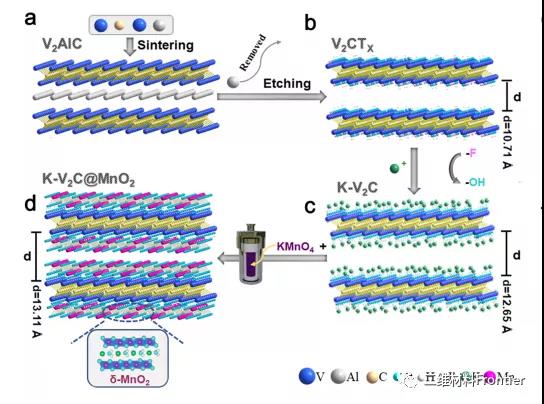
Figure 1 shows the synthesis diagram of .K -V2C@MnO2. (a) The structure of the V2AlC MAX phase obtained by sintering V, Al, and c. (b) V2CTX MXene obtained by hf etching. (c) The interaction between alkalized V2CTX and K+ ions. (d) MnO2 modified pre-alkalized V2CTX through the template effect and in-situ growth process.
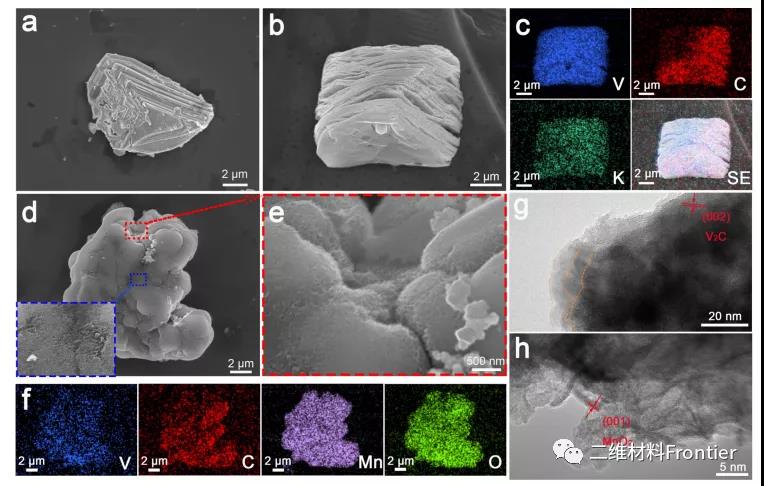
Figure 2. SEM images of (a) V2AlC MAX phase and (b) kv2c phase. (c) Element mapping corresponding to V, c, K (d, e) K V2C@MnO2 SEM image (f) Element mapping corresponding to V, C, Mn, O. (g) HRTEM image of K−V2C@MnO2. (h) HRTEM image of K−V2C@MnO2 with higher magnification.
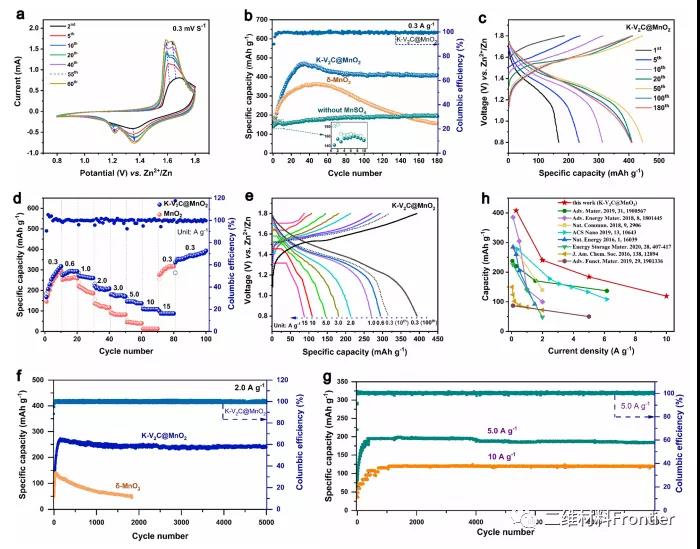
Figure 3. (a) After different cycles, the CV curve of the K−V2C@MnO2 electrode at a scan rate of 0.3mV−1. (b) Cycle performance of K−V2C@manganese dioxide, K−V2C@K−V2C@MnO2 and δ-MnO2 electrodes without MnSO4 under 0.3Ag−1. (c) Constant current charge and discharge curve of K−V2C@MnO2 at 0.3Ag−1. (d) Rate performance of δ-MnO2 and K−V2C@MnO2 electrodes. (e) Constant current charge and discharge curves of K−V2C@MnO2 electrode at different current densities. (f) The long-term cycle performance of δ-MnO2 and K−V2C@MnO2 electrodes under 2.0Ag−1 conditions. (g) The long-term cycling performance of K−V2C@MnO2 at a fairly high current density. (h) Compared with the reported Mn-based cathode, the specific capacity of the K−V2C@MnO2 electrode is stable at different current densities.

Figure 4. (a) CV curve of K−V2C@MnO2 electrode at different scan rates. (b) The logi and logv plots at a specific peak current. (c) The contribution ratio of capacitance capacity and diffusion control capacity in kV2C@MnO2 electrode. (d) GITT curves and corresponding ion diffusion coefficients of kV2C@MnO2 and δ-MnO2 under charge and discharge conditions. (e) Nyquist diagrams of K-V2C@MnO2 and δ-MnO2 cathodes at the initial open circuit potential (the inset is the equivalent circuit of the fitted electrical impedance spectrum). (f) Band edge position of δ-MnO2 and V2C. (g) DOS of δ-MnO2, V2C and MnO2-V2C. (h) Calculate the absorption energy of Zn2+ on the surface of MnO2-V2C and δ-MnO2.
Third, the full text summary
In summary, the manganese-based cathode material of MnO2 nanosheets coated with layered V2CTX MXene is beneficial to improve the specific capacity, rate performance and cycle life of zib. Using the strategy of K+ ion intercalation and in-situ growth, an advanced K-V2C@MnO2 hybrid was successfully synthesized, which is an advanced manganese-vanadium composite zinc ion storage cathode. Physical characterization and electrochemical research k-V2C@MnO2 electrode has considerable structural stability and high reversibility. In addition, combined with electrical analysis, simulation calculation, synchronous XANES and EXAFS technology, the Zn2+ insertion/extraction mechanism and phase transition of the K V2C@MnO2 electrode are explained. Compared with most existing ZIBs cathode materials, K−V2C@MnO2 has the advantages of a conductive substrate and high surface activity, as well as excellent rate performance, high capacity and cycle stability. Specifically, K−V2C@MnO2 and Mn2+ electrodeposition enhance the synergistic reaction and suppress structural damage by manganese dioxide, reaching a magical capacity of 408.1mAhg−1 at 0.3Ag−1, which is the best Zn2+ for manganese cathodes reported previously. capacity. In addition, even at a fairly high rate of 10Ag−1, K−V2C@MnO2 still maintains an achievable capacity of 119.2mAhg−1 after 10,000 cycles. The results show that K−V2C@MnO2 is a promising high-performance zib cathode material. In addition, this work not only provides an idea for further understanding of the zinc ion insertion process, but also provides a method for the development of low-cost, high reversibility, high stability and safety water batteries.
This information is sourced from the Internet for academic exchanges. If there is any infringement, please contact us to delete it immediately
18915694570
Previous: Jiang Hulin AM, China


